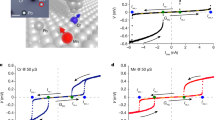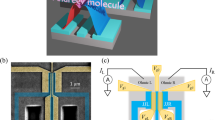Abstract
Second-order topological insulators are characterized by helical, non-spin-degenerate one-dimensional states running along opposite crystal hinges with no backscattering. Injecting superconducting pairs therefore entails splitting Cooper pairs into two families of helical Andreev states of opposite helicity, one at each hinge. Here we provide evidence for such separation via the measurement and analysis of the switching supercurrent statistics of a crystalline nanoring of bismuth. Using a phenomenological model of two helical Andreev hinge modes, we find that pairs relax at a rate comparable to individual quasiparticles, in contrast to the much faster pair relaxation of non-topological systems. This constitutes a unique telltale sign of the spatial separation of topological helical hinges.
This is a preview of subscription content, access via your institution
Access options
Access Nature and 54 other Nature Portfolio journals
Get Nature+, our best-value online-access subscription
$29.99 / 30 days
cancel any time
Subscribe to this journal
Receive 12 print issues and online access
$209.00 per year
only $17.42 per issue
Buy this article
- Purchase on Springer Link
- Instant access to full article PDF
Prices may be subject to local taxes which are calculated during checkout





Similar content being viewed by others
Data availability
The switching current data are available via Zenodo at https://doi.org/10.5281/zenodo.7119795.
Code availability
The MATLAB files for calculating the joint probabilities and switching histograms are available via GitHub at https://github.com/pengyangraul/BiJunction_Codes.
References
Kane, C. L. & Mele, E. J. Z2 topological order and the quantum spin Hall effect. Phys. Rev. Lett. 95, 146802 (2005).
Bernevig, B. A., Hughes, T. L. & Zhang, S.-C. Quantum spin Hall effect and topological phase transition in HgTe quantum wells. Science 314, 1757–1761 (2006).
Schindler, F. et al. Higher-order topological insulators. Sci. Adv. 4, eaat0346 (2018).
Song, Z., Fang, Z. & Fang, C. (d − 2)-dimensional edge states of rotation symmetry protected topological states. Phys. Rev. Lett. 119, 246402 (2017).
Langbehn, J., Peng, Y., Trifunovic, L., von Oppen, F. & Brouwer, P. W. Reflection-symmetric second-order topological insulators and superconductors. Phys. Rev. Lett. 119, 246401 (2017).
Kwon, H.-J., Sengupta, K. & Yakovenko, V. M. Fractional ac Josephson effect in p- and d-wave superconductors. Eur. Phys. J. B 37, 349–361 (2004).
Fu, L. & Kane, C. L. Josephson current and noise at a superconductor/quantum-spin-Hall-insulator/superconductor junction. Phys. Rev. B 79, 161408 (2009).
Zhang, F. & Kane, C. L. Time-reversal-invariant Z4 fractional Josephson effect. Phys. Rev. Lett. 113, 036401 (2014).
Peng, Y., Vinkler-Aviv, Y., Brouwer, P. W., Glazman, L. I. & von Oppen, F. Parity anomaly and spin transmutation in quantum spin Hall Josephson junctions. Phys. Rev. Lett. 117, 267001 (2016).
Bocquillon, E. et al. Gapless Andreev bound states in the quantum spin Hall insulator HgTe. Nat. Nanotechnol. 12, 137–143 (2017).
Deacon, R. S. et al. Josephson radiation from gapless Andreev bound states in HgTe-based topological junctions. Phys. Rev. X 7, 021011 (2017).
Murani, A. et al. Microwave signature of topological Andreev level crossings in a bismuth-based Josephson junction. Phys. Rev. Lett. 122, 076802 (2019).
Lee, S.-P., Michaeli, K., Alicea, J. & Yacoby, A. Revealing topological superconductivity in extended quantum spin Hall Josephson junctions. Phys. Rev. Lett. 113, 197001 (2014).
Peng, Y., Pientka, F., Berg, E., Oreg, Y. & von Oppen, F. Signatures of topological Josephson junctions. Phys. Rev. B 94, 085409 (2016).
Frombach, D. & Recher, P. Quasiparticle poisoning effects on the dynamics of topological Josephson junctions. Phys. Rev. B 101, 115304 (2020).
Crépin, F. & Trauzettel, B. Parity measurement in topological Josephson junctions. Phys. Rev. Lett. 112, 077002 (2014).
Zgirski, M. et al. Evidence for long-lived quasiparticles trapped in superconducting point contacts. Phys. Rev. Lett. 106, 257003 (2011).
Beenakker, C. W. J., Pikulin, D. I., Hyart, T., Schomerus, H. & Dahlhaus, J. P. Fermion-parity anomaly of the critical supercurrent in the quantum spin-Hall effect. Phys. Rev. Lett. 110, 017003 (2013).
Schindler, F. et al. Higher-order topology in bismuth. Nat. Phys. 14, 918–924 (2018).
Li, C. et al. Magnetic field resistant quantum interferences in Josephson junctions based on bismuth nanowires. Phys. Rev. B 90, 245427 (2014).
Drozdov, I. K. et al. One-dimensional topological edge states of bismuth bilayers. Nat. Phys. 10, 664–669 (2014).
Takayama, A., Sato, T., Souma, S., Oguchi, T. & Takahashi, T. One-dimensional edge states with giant spin splitting in a bismuth thin film. Phys. Rev. Lett. 114, 066402 (2015).
Murani, A. et al. Ballistic edge states in bismuth nanowires revealed by SQUID interferometry. Nat. Commun. 8, 15941 (2017).
Jäck, B. et al. Observation of a Majorana zero mode in a topologically protected edge channel. Science 364, 1255–1259 (2019).
Kumar Nayak, A. et al. Resolving the topological classification of bismuth with topological defects. Sci. Adv. 5, eaax6996 (2019).
Aggarwal, L., Zhu, P., Hughes, T. L. & Madhavan, V. Evidence for higher order topology in Bi and Bi0.92Sb0.08. Nat. Commun. 12, 4420 (2021).
Cayssol, J., Kontos, T. & Montambaux, G. Isolated hybrid normal/superconducting ring in a magnetic flux: from persistent current to Josephson current. Phys. Rev. B 67, 184508 (2003).
Delagrange, R. et al. Manipulating the magnetic state of a carbon nanotube Josephson junction using the superconducting phase. Phys. Rev. B 91, 241401 (2015).
Crépin, F. & Trauzettel, B. Flux sensitivity of quantum spin Hall rings. Phys. E 82, 185–190 (2016).
Olivares, D. G. et al. Dynamics of quasiparticle trapping in Andreev levels. Phys. Rev. B 89, 104504 (2014).
Hays, M. et al. Direct microwave measurement of Andreev-bound-state dynamics in a semiconductor-nanowire Josephson junction. Phys. Rev. Lett. 121, 047001 (2018).
Hays, M. et al. Coherent manipulation of an Andreev spin qubit. Science 373, 430–433 (2021).
Janvier, C. et al. Coherent manipulation of Andreev states in superconducting atomic contacts. Science 349, 1199–1202 (2015).
Hsu, Chen-Hsuan, Stano, P., Klinovaja, J. & Loss, D. Majorana Kramers pairs in higher-order topological insulators. Phys. Rev. Lett. 121, 196801 (2018).
Kononov, A. et al. One-dimensional edge transport in few-layer WTe2. Nano Lett. 20, 4228–4233 (2020).
Li, Cai-Zhen et al. Reducing electronic transport dimension to topological hinge states by increasing geometry size of Dirac semimetal Josephson junctions. Phys. Rev. Lett. 124, 156601 (2020).
Yu, A. et al. Supercurrents through single-walled carbon nanotubes. Science 284, 1508–1511 (1999).
Acknowledgements
We acknowledge useful discussions with M. Aprili, C. Girit, M. Houzet, J. Meyer, H. Pothier, P. Simon and C. Urbina, technical help from S. Autier-Laurent and funding from the French programme ANR JETS (ANR-16-CE30-0029-01), the European Research Council (ERC) under the European Union’s Horizon 2020 research and innovation programme (grant Ballistop agreement no. 833350), LabEx PALM (ANR-10-LABX-0039-PALM) JosephBismuth, CRC 183 (project C02) of Deutsche Forschungsgemeinschaft (Y.O. and F.v.O.), the European Union’s Horizon 2020 research and innovation programme (grant agreement LEGOTOP no. 788715) (Y.O.), ISF Quantum Science and Technology (grant no. 2074/19) (Y.O.) and a BSF and NSF grant (2018643) (Y.O.). Y.P. is supported by an NSF grant (no. PHY-2216774) and the startup fund from California State University, Northridge.
Author information
Authors and Affiliations
Contributions
A.K. and V.T.V. grew the Bi nanowires and A.K. deposited them on the substrate. Yu.A.K. characterized the nanowire growth. F.F., A.B. and A.K. selected the nanowires and connected them using focused-ion-beam-assisted deposition. A.B. conducted the low-temperature measurements with input from M.F., R.D., S.G. and H.B. A.B., M.F., R.D., S.G., H.B., Y.P., F.v.O. and Y.O. analysed the data and discussed the results. Y.P., F.v.O. and Y.O. developed the model, and Y.P. wrote the code. S.G., H.B., A.B., R.D., Y.P., F.v.O. and Y.O. wrote the paper.
Corresponding author
Ethics declarations
Competing interests
The authors declare no competing interests.
Peer review
Peer review information
Nature Physics thanks Mercedeh Khajavikhan and the other anonymous reviewer(s) for their contribution to the peer review of this work.
Additional information
Publisher’s note Springer Nature remains neutral with regard to jurisdictional claims in published maps and institutional affiliations.
Supplementary information
Supplementary Information
Supplementary Sections 1–5, Figs. 1–10 and references.
Rights and permissions
Springer Nature or its licensor (e.g. a society or other partner) holds exclusive rights to this article under a publishing agreement with the author(s) or other rightsholder(s); author self-archiving of the accepted manuscript version of this article is solely governed by the terms of such publishing agreement and applicable law.
About this article
Cite this article
Bernard, A., Peng, Y., Kasumov, A. et al. Long-lived Andreev states as evidence for protected hinge modes in a bismuth nanoring Josephson junction. Nat. Phys. 19, 358–364 (2023). https://doi.org/10.1038/s41567-022-01858-8
Received:
Accepted:
Published:
Issue Date:
DOI: https://doi.org/10.1038/s41567-022-01858-8
This article is cited by
-
Cooperativity in regulation of membrane protein function: phenomenological analysis of the effects of pH and phospholipids
Biophysical Reviews (2023)
-
Growth of bismuth nanowires stimulated by Fe islands
Applied Physics A (2023)



